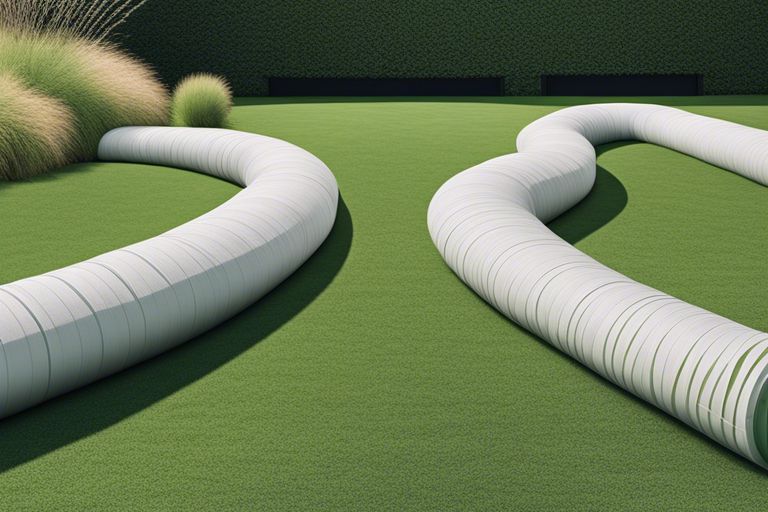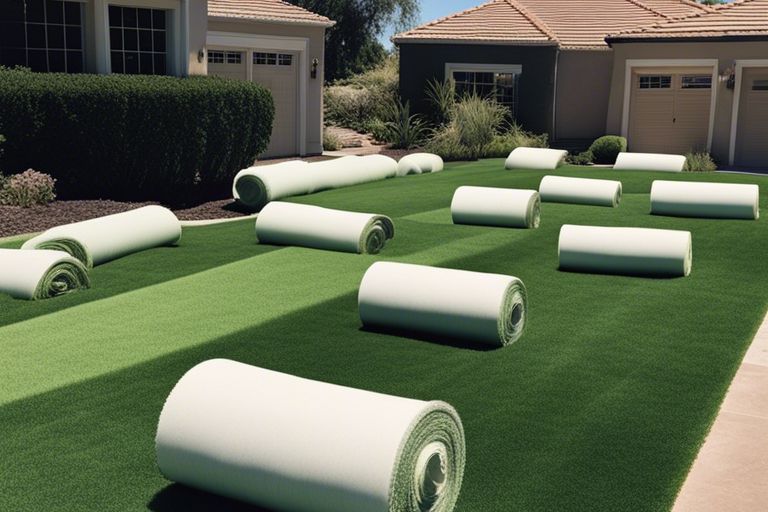With a little guidance, you can transform your outdoor space into a lush, vibrant landscape by installing grass rolls that last for years. The process may seem straightforward, yet there are unique techniques that can significantly enhance the durability and vitality of your new lawn. By paying attention to key factors such as soil preparation, roll placement, and ongoing care, you can ensure your grass not only survives but thrives. Join us on this journey to discover the secrets that will help your lawn flourish for generations to come.
Key Takeaways:
- Proper Preparation: Ensure the soil is well-aerated, leveled, and free of debris to create an ideal foundation for the grass rolls.
- Seam Alignment: Stagger the seams between rolls to prevent visible lines and promote healthier root growth and soil coverage.
- Consistent Watering: Implement a regular watering schedule immediately after installation to help the grass establish roots and retain moisture for longevity.
Preparation is Key
A successful grass roll installation begins long before the sod ever touches the soil. The right preparation ensures that your new lawn will not only thrive but will also endure the test of time. Every step you take in the preparation phase contributes to the overall health and vibrancy of your grass. A well-prepared site will foster a strong foundation for your grass rolls, leading to lush greenery that you can enjoy for years to come.
Choosing the Right Grass Type
For many homeowners, the choice of grass type is a crucial first step. Your region’s climate, as well as the specific conditions of your yard—sunlight, soil type, and water availability—will dictate which grass variety is best suited for your needs. Cool-season grasses, such as Kentucky bluegrass, thrive in northern regions, while warm-season varieties like Bermuda grass flourish in southern climates. Evaluating your environment will help you select the perfect grass that delights your senses, offering vibrant colors and a soft texture.
Preparing the Soil
To foster healthy growth, meticulous soil preparation is necessary. Begin by removing any existing weeds, debris, or old sod that may hinder your new grass rolls from taking root. After clearing the area, it is important to till the soil to a depth of at least six inches. This process not only aerates the soil but also promotes deeper root growth, ensuring a stable foundation for your grass. Additionally, mixing in organic matter, such as compost, can enhance soil fertility and improve water retention.
Understanding the soil type in your yard can significantly affect your grass’s long-term health. If your soil is compacted or heavily clay-based, consider using a soil testing kit to determine nutrient levels and pH balance. Adjustments might be necessary to create an optimal environment for growth. For instance, adding lime may help balance acidic soils, while sulfur can lower pH in overly alkaline conditions. Bear in mind, the health of your grass directly correlates to the quality of the soil it grows in. Taking the time to prepare your soil thoroughly will yield impressive results, leading to a lush and durable lawn that can withstand various environmental challenges.
Laying the Foundation
While it may seem daunting, laying the groundwork for your grass rolls is an necessary step that sets the stage for a vibrant and lasting lawn. The foundation process includes meticulous measuring, preparation, and ensuring that the area is primed for optimal growth. Following these guidelines will create a thriving environment for your new grass rolls, ultimately leading to a lush and resilient lawn.
Measuring and Marking the Area
Measuring the area accurately is crucial to ensure that you have enough grass rolls to cover your lawn without any gaps or overlaps. Begin by using a measuring tape to determine the length and width of your designated lawn area. Mark the corners with stakes or spray paint to outline the space clearly. This preparation is not just about aesthetics; it also helps in calculating the square footage, allowing you to purchase the right amount of grass rolls and minimize waste.
After you have established the measurements, it’s wise to assess the contours of your landscape. If there are slopes or depressions, factor these in during your planning. This precision in measuring guarantees a smoother installation process, leading to an evenly laid lawn that will thrive in its new environment.
Clearing Debris and Leveling the Ground
On begining upon this transformative journey, the next step involves clearing away debris and leveling the ground to provide a flawless surface for your grass rolls. Begin by removing any stones, branches, or remnants that may hinder the laying of your grass. This step is vital, as any debris left behind could create uneven surfaces, leading to poor root establishment and potential weak spots in your lawn.
Clearing the area not only sets a solid foundation but also fosters a healthy ecosystem for your grass to thrive. Once you have removed the debris, you should turn your attention to leveling the ground. An uneven surface can lead to water pooling in certain areas, which can cause root rot or disease in your newly laid grass. To achieve a smooth surface, use a rake to spread the soil evenly, aiming for a gentle slope away from buildings to encourage proper drainage. When completed, your preparation will serve as a strong backbone for maintaining a beautiful, healthy lawn.

Unrolling and Securing
Now that you have chosen the ideal location for your grass rolls, it’s time to proceed with the unrolling process. Ensuring your rolls are positioned correctly is crucial for achieving a lush and healthy lawn. As you start unrolling, take extra care not to damage the delicate roots that are nestled within the rolls. Gently lay the grass down on prepared soil, making sure that it remains well-aligned with the surrounding turf. An organized installation will allow for more seamless growth, providing you with the stunning lawn you desire.
Unrolling the Grass Rolls
On the day of installation, timing is key. If you can, unroll your grass rolls in the early morning or late afternoon to prevent heat stress, which can harm the newly installed grass. Ensure you work quickly but carefully; as you lay each roll, overlap them slightly with the edge of the previous roll to prevent bare spots. This technique allows for quicker rooting and creates a stunning green expanse in no time.
Securing the Rolls with Staples or Pins
Any time you lay grass rolls, it is vital to secure them properly. Using landscape staples or pins helps keep the edges in place, which is especially important on slopes or windy days. Position these staples approximately every 12 to 18 inches along the seams, adjusting the distance based on environmental factors or the slope of your lawn. This not only prevents your grass from shifting but also encourages roots to anchor into the soil more thoroughly.
Rolls should be anchored down firmly, as wind may seek to lift and displace them. The use of staples or pins offers a stronghold against nature’s elements while promoting an environment where the grass can establish itself swiftly. With your grass rolls secure, you can rest easy knowing that you have taken significant steps towards building a vibrant and resilient lawn that will thrive for years to come.
Watering and Maintenance
For the stellar establishment of your grass rolls, **the initial watering** is paramount. After installation, you must ensure that your new lawn receives a thorough watering, ideally within the first 30 minutes. This is crucial to help the roots establish contact with the soil beneath. A gentle soak, where the top inch of the soil becomes moist but not waterlogged, will support this process. Mundanely, you may think of it as simply dousing the grass, yet it is a vital step in fostering a healthy, robust lawn that will flourish in the days to come. Continue this watering regime daily for the first week, gradually reducing the frequency as the rolls start to root into the soil.
Initial Watering and Establishment
With a keen eye on weather conditions, aim to provide at least 1 inch of water per week once your grass has begun to take root. Seek to deliver this through deep watering, as this promotes a strong root system. You can gauge whether your efforts have been successful by tugging lightly on a corner of the grass; if it resists, that’s a strong indication of establishment. As with any living organism, nurturing your new grass in those early weeks sets the stage for a thriving ecosystem. Your diligence now will pay dividends in the months ahead.
Ongoing Care and Maintenance
Any vibrant lawn requires ongoing care and attention to detail. It is vital that you monitor your grass for any signs of distress, such as yellowing or wilting. **A consistent mowing schedule** will promote healthy growth and prevent weeds from taking hold. You should aim to mow when the grass reaches about 3 inches in height, cutting no more than one-third of the blade length at a time to maintain resilience. Ensuring that your mower blades are sharp will aid in achieving clean cuts, which significantly reduce the risk of disease.
Maintenance is a journey you begin upon with your grass rolls. **Regular fertilization** and watering—matching your local climate conditions—are vital to establish season-long vigor. Consider utilizing **organic options** that enrich the soil naturally, fostering an environment conducive to growth. Be mindful of, too much water can be as damaging as too little; it’s about finding a balance that complements your lawn’s needs. Each blade of grass is a part of a larger ecosystem that thrives under your care, so tend to it lovingly, and it will reward you with lush green expanses for years to come.
Dealing with Common Issues
Once again, the beauty of your newly installed grass rolls can be marred by common problems that arise shortly after laying them down. Whether you encounter issues with weeds, pests, or improper soil conditions, understanding how to address these concerns is important for the longevity of your lawn. Tips for Getting the Best Results from Sod Grass will help you navigate these challenges effectively, ensuring your grass thrives as intended.
Weeds and Pests
For any garden enthusiast, the emergence of pesky weeds and invasive pests can be a disheartening sight. They thrive on the nutrients intended for your blue-green carpet of grass, competing for space and resources. To tackle this, you must adopt a proactive approach; consider a combination of natural and chemical deterrents, and use mulch around the base of your sod during its initial growth period to prevent unwanted plant life from invading. Regularly monitoring your lawn will also enable you to spot and address any unwelcome guests promptly, ensuring a healthy, thriving environment for your grass.
For pests, practical measures such as introducing beneficial insects, like ladybugs and predatory mites, can keep populations in check. Proper maintenance and care for your sod can also reduce the likelihood of pest infestations and weed growth. Utilizing organic herbicides can further safeguard your grass, keeping it lush and vibrant. Maintain vigilance and your efforts will surely pay off in a flourishing landscape.
Compaction and Drainage
Common issues related to lawn health often stem from improper soil compaction and drainage. Your grass roots need room to grow and absorb important nutrients, while adequate drainage prevents waterlogging that can lead to fungal diseases. Compact soil can restrict root development, resulting in weaker grass that is susceptible to pests and disease. This very issue can be remedied through regular aeration, providing necessary breaks in the soil where air, water, and nutrients can penetrate deeply.
For instance, identifying heavy foot traffic areas and redressing them with mulch or decorative pavers can alleviate compaction while preserving your verdant oasis. Regular watering practices should be employed, ensuring that water drains effectively without pooling. It’s crucial to understand that the balance between moisture and drainage is important to create a thriving lawn. By addressing compaction and drainage issues in a timely manner, you set the stage for a resilient, long-lasting grass that adds beauty and value to your surroundings.
Tips for Long-Term Success
Despite the initial excitement of laying down your grass rolls, it is important to maintain their vitality and lushness. Achieving a thriving lawn requires attention to several key factors that contribute to longevity. Here are some vital tips to ensure your grass remains beautiful for years:
- Watering: Ensure consistent moisture without over-watering.
- Mowing: Maintain the right height and frequency.
- Fertilizing: Feed your grass to promote healthy growth.
- Aerating: Allow nutrients and water to penetrate the soil effectively.
- Pest Control: Stay alert to signs of infestations.
Any lawn enthusiast will tell you that mowing and edging are important components of maintaining a healthy lawn. By regularly cutting your grass to the correct height, you encourage strong root development, which ultimately results in a denser turf. Remember not to cut more than one-third of the grass blade in a single mowing session; this practice will prevent stress on your lawn. Additionally, edging gives your lawn a crisp, polished look while helping to define borders and prevent grass from encroaching into flower beds or walkways.
Mowing and Edging
Any diligent gardener understands that edging is just as crucial as mowing. The act of edging promotes cleaner lines, enhances the overall appearance, and minimizes the chances of *weeds* infiltrating your lawn. To achieve clear boundaries, you might consider using a lawn edger or even a spade. Investing time in maintaining your edges, coupled with proper mowing techniques, will ensure your grass enjoys optimal light access and air circulation, resulting in a robust and stunning landscape.
Fertilizing and Aerating
With proper fertilizing and aerating, you engage in a nurturing relationship with your lawn that fosters its long-term health. Fertilizing is important as it provides your grass with the necessary nutrients to flourish, while aerating allows important air, water, and nutrients to penetrate deeply into the soil, alleviating soil compaction that can impede growth. Consider fertilizing your grass in the spring and fall, while aeration can be performed during the growing season for best results.
A well-timed routine of fertilizing and aerating can significantly benefit your grass. A rich balance of nitrogen, phosphorus, and potassium in the fertilizer promotes strong root development, enhances green coloration, and creates a lush landscape. On the other hand, aerating opens up the soil, allowing for better water absorption and reducing the buildup of thatch. Just remember, applying too much fertilizer or performing aeration during peak heat can lead to detrimental effects, such as scorched grass or further soil compaction.
Any efforts you invest will reap significant rewards, leading to a verdant expanse that can be treasured for years to come.
Final Words
To wrap up, it is necessary to understand that installing grass rolls with intention and care can significantly influence the longevity of your lush green paradise. By choosing the right time for installation, preparing your soil meticulously, and ensuring proper watering and maintenance techniques, you can create an environment where your grass can thrive. Just as nature requires nurturing to flourish, so does your landscape, transforming it into a beautiful testament to your dedication.
Note, the journey of establishing your verdant haven doesn’t end with installation; it is an ongoing relationship that you must cultivate. By applying unique techniques and being attuned to your lawn’s needs, you ensure that your grass rolls not only survive but flourish, creating a stunning canvas for life’s moments. Embrace this opportunity to foster beauty in your surroundings, and witness the remarkable transformation that patiently awaits just beyond your doorstep.
Q: What are the best practices for preparing the soil before installing grass rolls?
A: Proper soil preparation is crucial for ensuring the longevity of grass rolls. Start by removing any debris, rocks, or weeds in the installation area. Then, till the soil to a depth of about 4-6 inches to aerate it. After tilling, level the ground using a rake to create an even surface. It’s also important to test the soil pH and nutrient levels, amending it as necessary to create optimal growing conditions. Adding organic matter like compost can improve soil structure and fertility, promoting healthier grass growth.
Q: How can I properly install grass rolls to ensure they adhere well to the soil?
A: To achieve good adherence of grass rolls to the soil, start by placing the rolls in a staggered pattern, similar to bricks in a wall. This helps to avoid any seams that may attract weeds or become uneven. Press the edges of the rolls together firmly to eliminate gaps. After laying the grass rolls, use a roller or by walking gently on the surface to ensure they make good contact with the soil beneath. Water the installation immediately after laying the rolls to help them settle in and establish roots.
Q: What additional care is required after installing grass rolls to maximize their lifespan?
A: After installation, consistent care is vital for maximizing the lifespan of grass rolls. Begin by providing adequate water; grass rolls typically require daily watering for the first week. Gradually reduce the frequency but ensure deep watering to encourage root growth. Avoid mowing too soon; let the grass establish for at least a few weeks. Fertilizing with a slow-release formula once the grass starts to grow can also help it become strong and resilient. Regular maintenance, including aeration, overseeding, and pest management, will further support the longevity of your grass rolls.


